Deformation Mechanism in Mechanically Coupled Polymer–Metal Hybrid Joints
Abstract
1. Introduction
2. Materials and Methods
2.1. Metal-Insert Preparation
2.2. Injection-Overmolding Procedure
2.3. Mechanical-Test Conditions, Thermography, and Microscopy Observation
3. Results and Discussion
3.1. Lap-Shear Test Results
3.2. IR Thermography Validation of Tensile Tests
4. Conclusions
Author Contributions
Funding
Conflicts of Interest
References
- Grujicic, M.; Sellappan, V.; Arakere, G.; Seyr, N.; Erdmann, M. Computational feasibility analysis of direct-adhesion polymer-to-metal hybrid technology for load-bearing body-in-white structural components. J. Mater. Process. Technol. 2008, 195, 282–298. [Google Scholar] [CrossRef]
- Paul, H.; Luke, M.; Henning, F. Combining mechanical interlocking, force fit and direct adhesion in polymer–metal-hybrid structures–evaluation of the deformation and damage behavior. Compos. B Eng. 2015, 73, 158–165. [Google Scholar] [CrossRef]
- Lambiase, F.; Ko, D.C. Two-steps clinching of aluminum and Carbon Fiber Reinforced Polymer sheets. Compos. Struct. 2017, 164, 180–188. [Google Scholar] [CrossRef]
- Gwon, T.M.; Kim, J.H.; Choi, G.J.; Kim, S.J. Mechanical interlocking to improve metal–polymer adhesion in polymer-based neural electrodes and its impact on device reliability. J. Mater. Sci. 2016, 51, 6897–6912. [Google Scholar] [CrossRef]
- Xiping, L.F.L.; Ningning, G.; Can, Y.; Bin, W. Surface topography induced high injection joining strength of polymer–metal composite and fracture mechanism. Comp. Struct. 2018, 184, 545–553. [Google Scholar] [CrossRef]
- Ramani, K.; Moriarty, B. Thermoplastic bonding to metals via injection molding for macro-composite manufacture. Polym. Eng. Sci. 1998, 38, 870–877. [Google Scholar] [CrossRef]
- Fabrin, P.A.; Hoikkanen, M.E.; Vuorinen, J.E. Adhesion of thermoplastic elastomer on surface treated aluminum by injection molding. Polym. Eng. Sci. 2007, 47, 1187–1191. [Google Scholar] [CrossRef]
- Sasaki, H.; Kobayashi, I.; Sai, S.; Hirahara, H.; Oishi, Y.; Mori, K. Adhesion of ABS resin to metals treated with triazine trithiol monosodium aqueous solution. J. Adhes. Sci. Technol. 1999, 13, 523–539. [Google Scholar] [CrossRef]
- Honkanen, M.; Hoikkanen, M.E.; Vippola, M.; Vuorinen, J.; Lepistö, T. Metal–plastic adhesion in injection-molded hybrids. J. Adhes. Sci. Technol. 2009, 23, 1747–1761. [Google Scholar] [CrossRef]
- Drummera, D.; Schmachtenberg, E.; Hülder, G.; Meister, S. MK2—A novel assembly injection molding process for the combination of functional metal surfaces with polymer structures. J. Mat. Process. Technol. 2010, 210, 1852–1857. [Google Scholar] [CrossRef]
- Kimura, F.; Kadoya, S.; Kajihara, Y. Effects of molding conditions on injection molded direct joining using a metal with nano-structured surface. Prec. Eng. 2016, 45, 203–208. [Google Scholar] [CrossRef]
- Naritomi, M.; Andoh, N. Composite of Steel and Resin and Method for Manufacturing Same. U.S. Patent US 2010/0279120 A1, 4 November 2010. [Google Scholar]
- Lucchetta, G.; Marinello, F.; Bariani, P.F. Aluminum sheet surface roughness correlation with adhesion in polymer metal hybrid overmolding. CIRP Ann. Manuf. Technol. 2011, 60, 559–562. [Google Scholar] [CrossRef]
- Mitschang, P.; Velthuis, R.; Emrich, S.; Kopnarski, M. Induction heated joining of aluminum and carbon fiber reinforced nylon 66. J. Thermoplast. Compos. Mater. 2009, 22, 767–780. [Google Scholar] [CrossRef]
- Bergmann, J.P.; Stambke, M. Potential of laser-manufactured polymer–metal hybrid joints. Phys. Procedia 2012, 39, 84–91. [Google Scholar] [CrossRef]
- Schrickera, K.; Stambke, M.; Bergmann, J.P.; Bräutigama, K.; Henckella, P. Macroscopic surface structures for polymer–metal hybrid joints manufactured by laser based thermal joining. Phys. Procedia 2014, 56, 782–790. [Google Scholar] [CrossRef][Green Version]
- Kim, S.L.; Lyu, M.Y. Adhesive strengths between glass fiber-filled ABS and metal in insert molding with engraved and embossed metal surface treatments. Polym. Eng. Sci. 2019, 59, 96–100. [Google Scholar] [CrossRef]
- Rodríguez-Vidal, E.; Sanza, C.; Sorianoa, C.; Leunda, J.; Verhaegheba, G. Effect of metal micro-structuring on the mechanical behavior of polymer–metal laser T-joints. J. Mater. Proc. Technol. 2016, 229, 668–677. [Google Scholar] [CrossRef]
- Rodríguez-Vidal, E.; Sanz, C.; Lambarri, J.; Quintana, I. Experimental investigation into metal micro-patterning by laser on polymer–metal hybrid joining. Opt. Laser Technol. 2018, 104, 73–82. [Google Scholar] [CrossRef]
- Kleffel, T.; Drummer, D. Investigating the suitability of roughness parameters to assess the bond strength of polymer–metal hybrid structures with mechanical adhesion. Compos. Part B 2017, 117, 20–25. [Google Scholar] [CrossRef]
- Ghumatkar, A.; Budhe, S.; Sekhar, R.; Banea, M.D.; de Barros, S. Influence of adherend surface roughness on the adhesive bond strength. Lat. Am. J. Solids Struct. 2016, 13, 2356–2370. [Google Scholar] [CrossRef]
- Lambiase, F. Mechanical behaviour of polymer–metal hybrid joints produced by clinching using different tools. Mater. Des. 2015, 87, 606–618. [Google Scholar] [CrossRef]
- Lambiase, F. Jointability of different thermoplastic polymers with aluminum AA6082 sheets by mechanical clinching. Int. J. Adv. Manuf. Technol. 2015, 66, 2123–2131. [Google Scholar] [CrossRef]
- Lambiase, F.; Di Ilio, A. Mechanical clinching of metal–polymer joints. J. Mater. Process. Technol. 2015, 215, 12–19. [Google Scholar] [CrossRef]
- Ozlati, A.; Movahedi, M.; Tamizi, M.; Tartifzadeh, Z.; Alipour, S. An alternative additive manufacturing-based joining method to make Metal/Polymer hybrid structures. J. Manuf. Proc. 2019, 45, 217–226. [Google Scholar] [CrossRef]
- Feistauer, E.E.; Dos Santos, J.F.; Amancio-Filho, S.T. A Review on direct assembly of through the thickness reinforced metal–polymer composite hybrid structures. Polym. Eng. Sci. 2019, 59, 661–674. [Google Scholar] [CrossRef]
- Bula, K.; Szymanska, J.; Sterzynski, T.; Piasecki, A.; Wroblewski, R. Visualization of particles arrangement during filling stage of polyamide 6 – metal insert injection molding. Polym. Eng. Sci. 2019, 59, 271–278. [Google Scholar] [CrossRef]
- EN ISO 1465:2009. Standard, Adhesives–Determination of tensile lap-shear strength of bonded assemblies; British Standards Institution: London, UK, 2009. [Google Scholar]
- Sterzynski, T.; Bula, K. Visualization and flow velocity determination of molten polymers. Polimery 2019, 9, 569–576. [Google Scholar] [CrossRef]
- Sterzynski, T.; Bula, K.; Piasecka, M. The visualization of molten polymers: Direct and non-direct measurement techniques. In Proceedings of the Conference Technomer, Chemnitz University of Technology, Chemnitz, Germany, 7–8 November 2019; Gehde, M., Wagenknecht, U., Blos, P., Eds.; 2019; p. 76. [Google Scholar]
- Choi, W.J.; Kim, C.S. Effect of talc orientation and nonisothermal crystallization rate on crystal orientation on polypropylene in injection-molded polypropylene/ethylene-propylene rubber/talc blends. Polymer 2004, 45, 2393–2401. [Google Scholar] [CrossRef]
- Rajasekaran, K.; Tjong, J.; Nayak, S.K.; Sain, M. Numerical and experimental validation of natural fiber orientation in viscous fluid of injection cavity. J. Nat. Fibers 2017, 14, 634–644. [Google Scholar] [CrossRef]
- Bociaga, E.; Jaruga, T. Experimental investigation of polymer flow in injection mold. Arch. Mater. Sci. Eng. 2007, 28, 165–172. [Google Scholar]
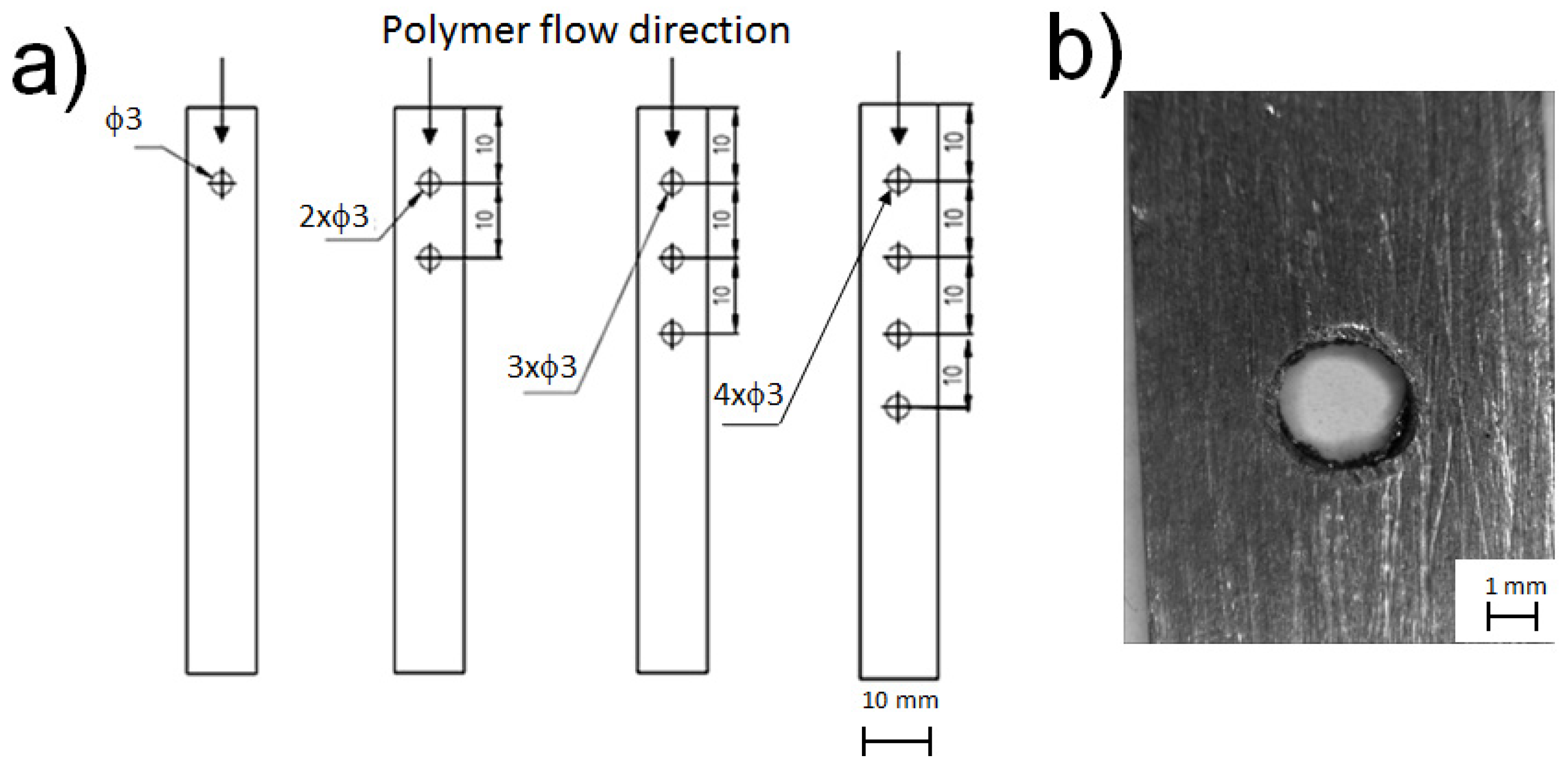
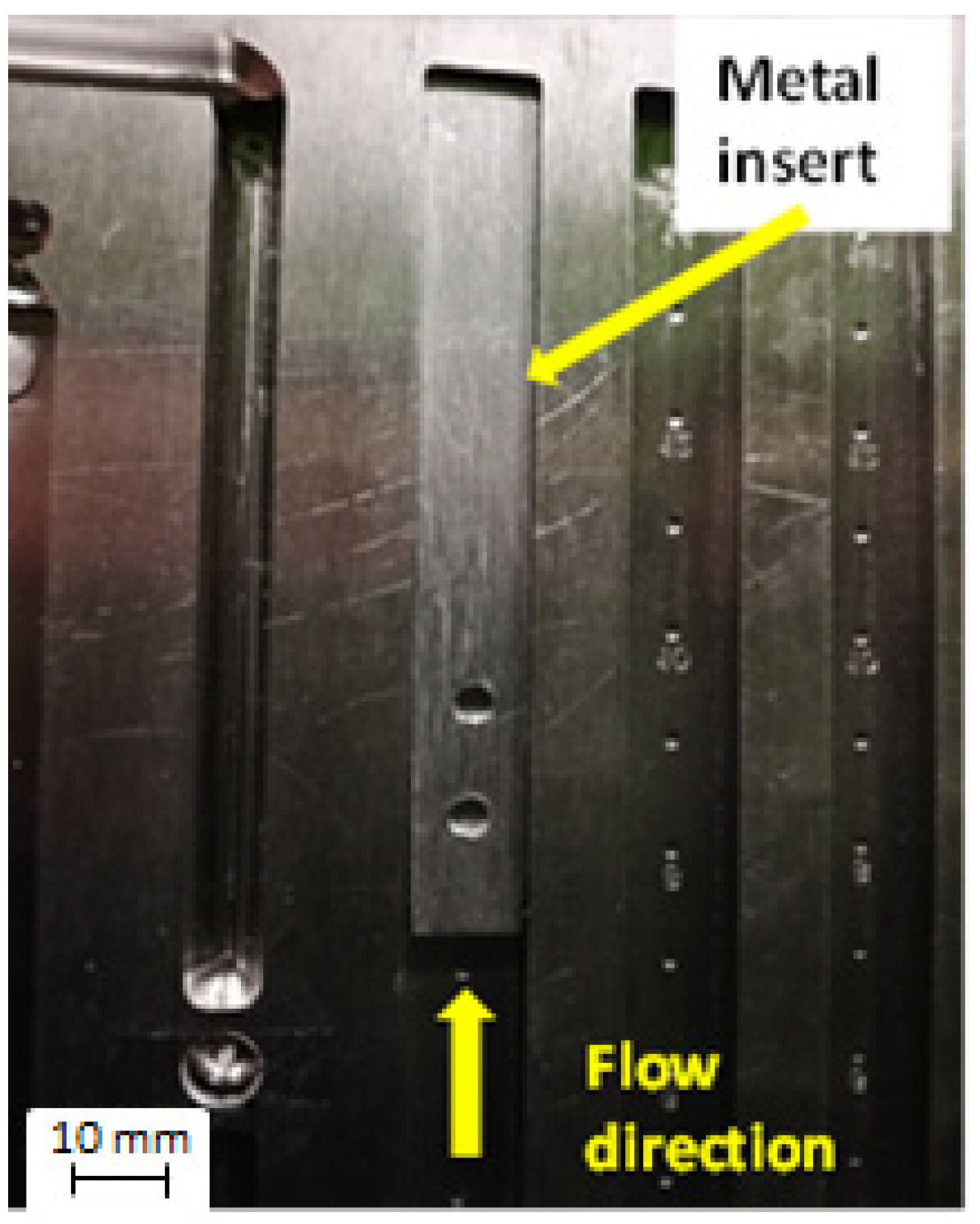
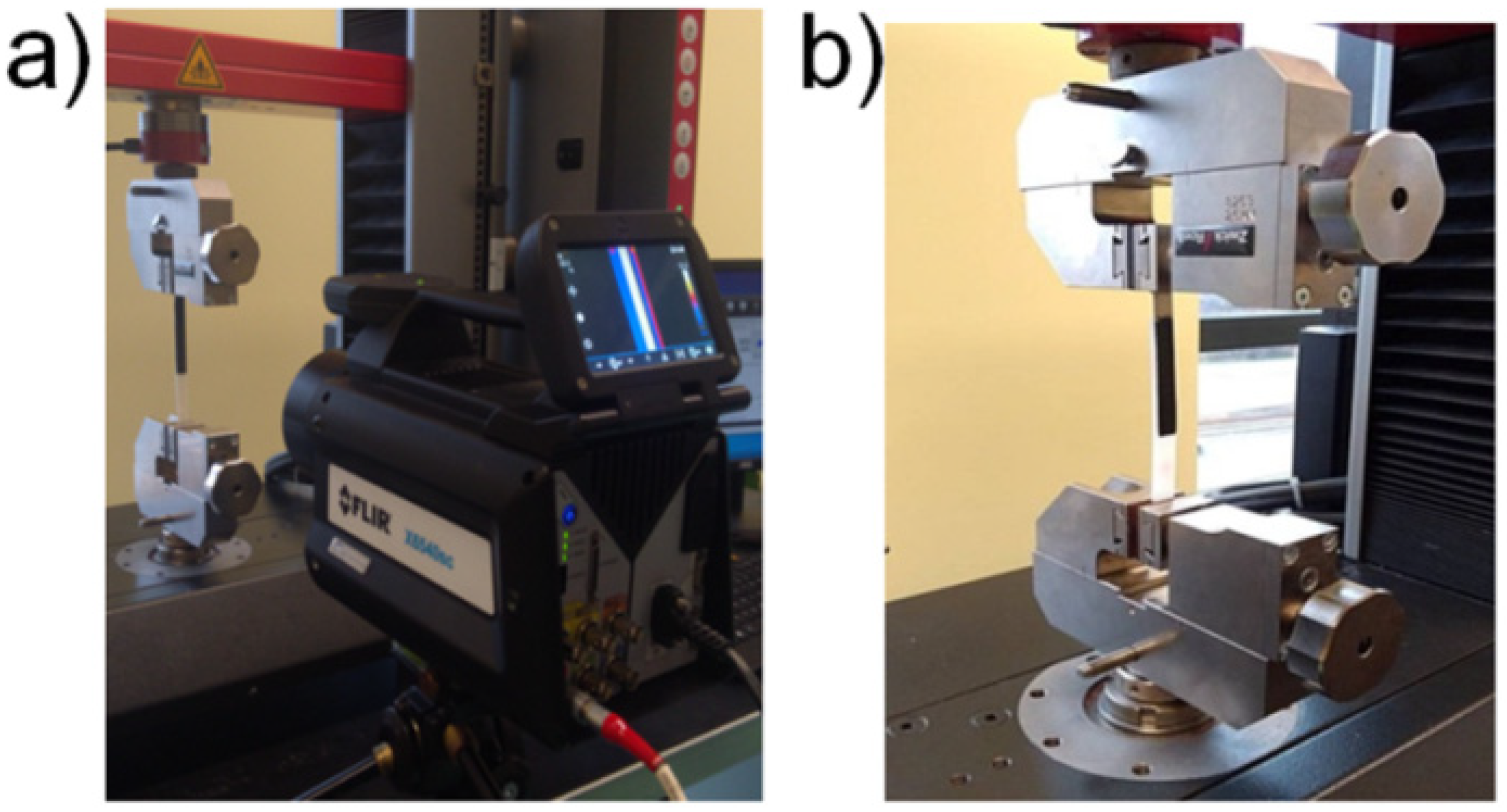

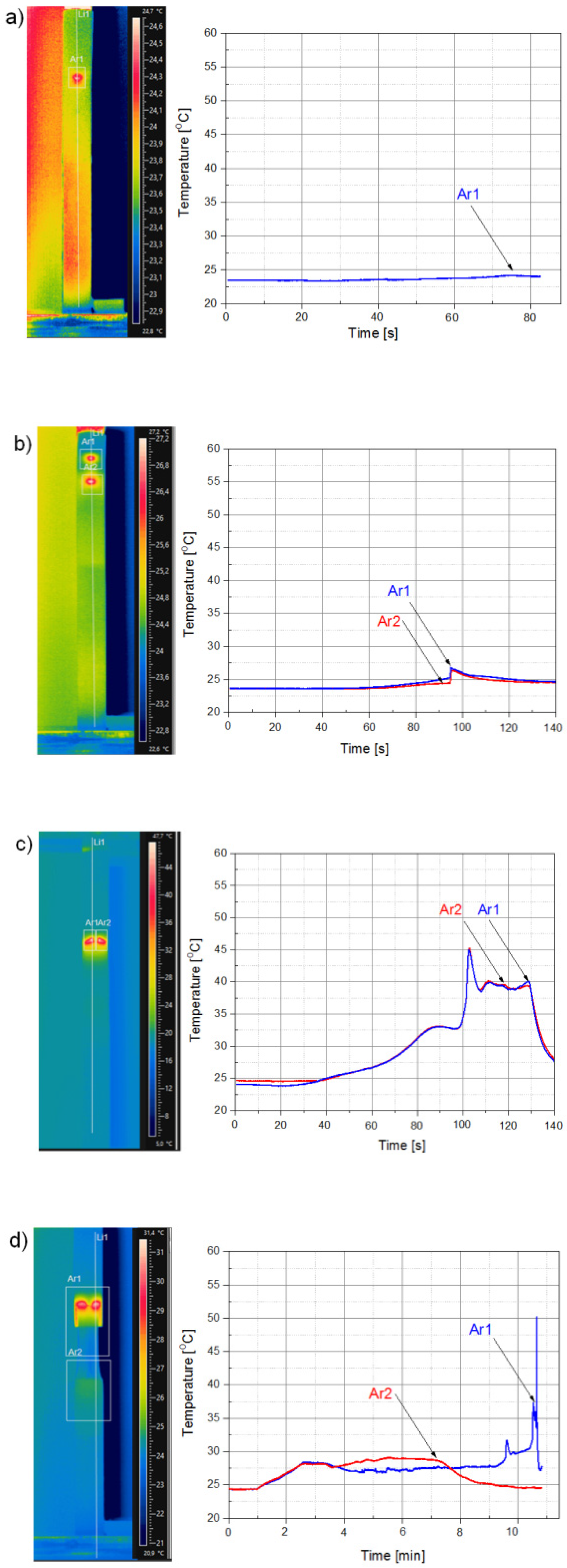
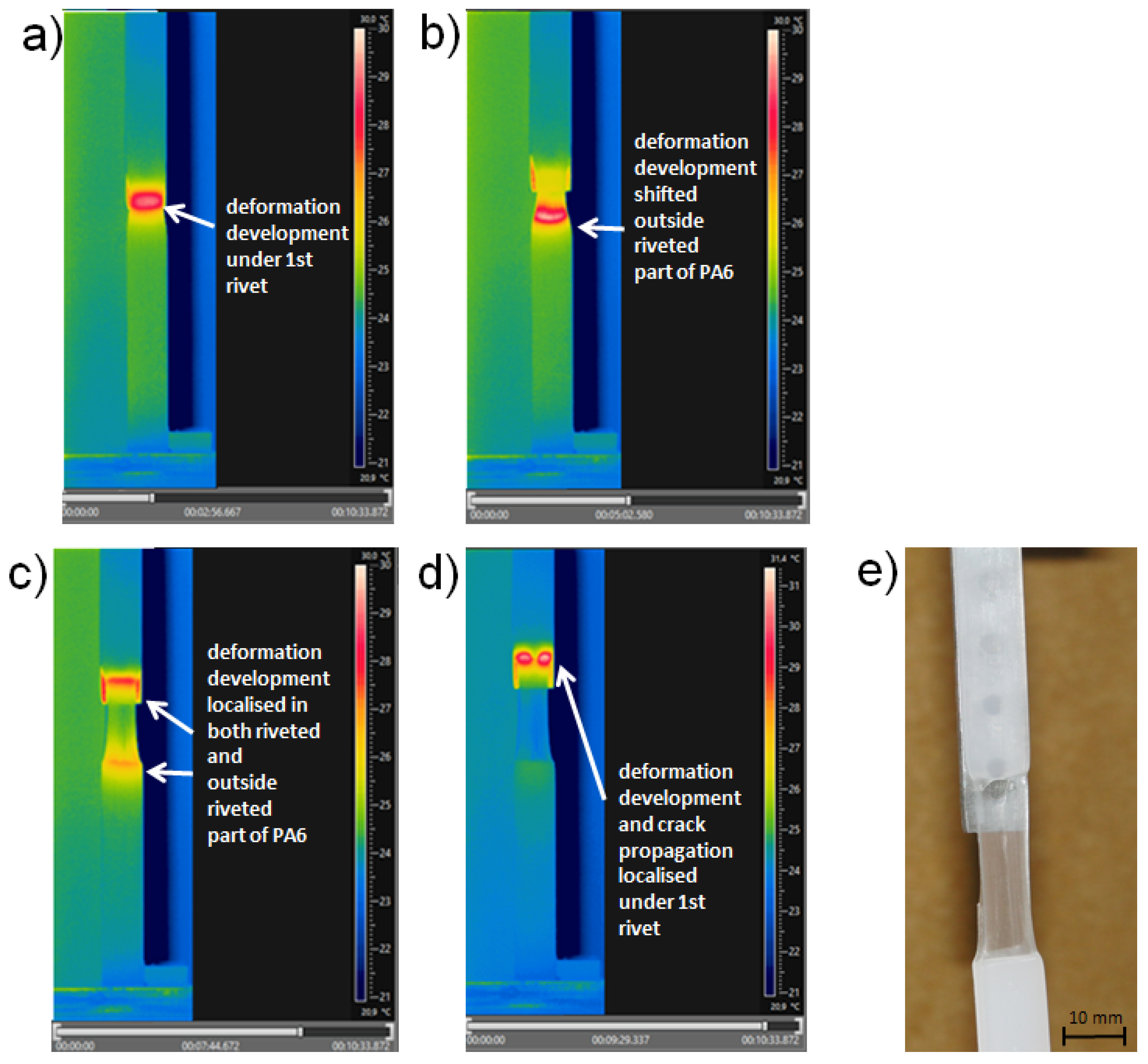
| Sample PA6/DC04 Single-Lap Joint | Maximal Force (N) | Standard Deviation (N) | Tensile strength (MPa) | Standard Deviation (MPa) | Maximal Temperature 2 (°C) | Specimen-Deformation Behavior |
|---|---|---|---|---|---|---|
| One rivet | 199 1 | 35 | − | − | 25.4 | Rivet pull-out |
| Two rivets | 476 | 93 | − | − | 27.5 | Rivet shear |
| Three rivets | 618 | 55 | 65.1 | 5.7 | 48.0 | Polymer part break |
| Four rivets | 606 | 14 | 63.7 | 1.5 | 55.0 | Polymer part break |
© 2020 by the authors. Licensee MDPI, Basel, Switzerland. This article is an open access article distributed under the terms and conditions of the Creative Commons Attribution (CC BY) license (http://creativecommons.org/licenses/by/4.0/).
Share and Cite
Bula, K.; Sterzyński, T.; Piasecka, M.; Różański, L. Deformation Mechanism in Mechanically Coupled Polymer–Metal Hybrid Joints. Materials 2020, 13, 2512. https://doi.org/10.3390/ma13112512
Bula K, Sterzyński T, Piasecka M, Różański L. Deformation Mechanism in Mechanically Coupled Polymer–Metal Hybrid Joints. Materials. 2020; 13(11):2512. https://doi.org/10.3390/ma13112512
Chicago/Turabian StyleBula, Karol, Tomasz Sterzyński, Maria Piasecka, and Leszek Różański. 2020. "Deformation Mechanism in Mechanically Coupled Polymer–Metal Hybrid Joints" Materials 13, no. 11: 2512. https://doi.org/10.3390/ma13112512
APA StyleBula, K., Sterzyński, T., Piasecka, M., & Różański, L. (2020). Deformation Mechanism in Mechanically Coupled Polymer–Metal Hybrid Joints. Materials, 13(11), 2512. https://doi.org/10.3390/ma13112512







